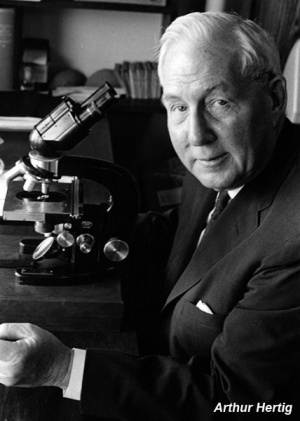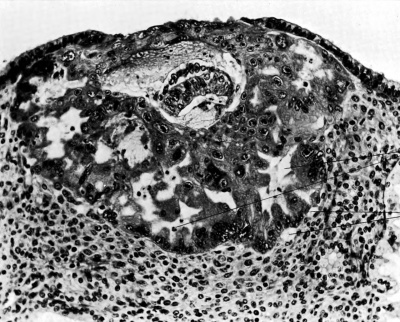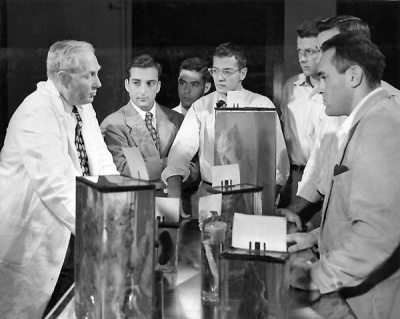Embryology History - Arthur Hertig
| Embryology - 28 Apr 2024 |
|---|
| Google Translate - select your language from the list shown below (this will open a new external page) |
|
العربية | català | 中文 | 中國傳統的 | français | Deutsche | עִברִית | हिंदी | bahasa Indonesia | italiano | 日本語 | 한국어 | မြန်မာ | Pilipino | Polskie | português | ਪੰਜਾਬੀ ਦੇ | Română | русский | Español | Swahili | Svensk | ไทย | Türkçe | اردو | ייִדיש | Tiếng Việt These external translations are automated and may not be accurate. (More? About Translations) |
Introduction
Prof Arthur Tremain Hertig (1904-1990) graduated from the University of Minnesota in 1928 and received his M.D. degree from Harvard University in 1930. He was been assistant professor of pathology at the Harvard Medical School since 1941. He is pathologist to the Boston Lying-in Hospital and to the Free Hospital for Women in Brookline. He was professor of pathology at Harvard Medical School and chairman of the school's Department of Pathology (1952 to 1968). A pathologist and researcher on human embryology. He also contributed to the development by others of the contraceptive pill and in vitro fertilization.
His early papers were often co-authored with John Rock and included embryos that were incorporated into the Carnegie Collection.
| Embryologists: William Hunter | Wilhelm Roux | Caspar Wolff | Wilhelm His | Oscar Hertwig | Julius Kollmann | Hans Spemann | Francis Balfour | Charles Minot | Ambrosius Hubrecht | Charles Bardeen | Franz Keibel | Franklin Mall | Florence Sabin | George Streeter | George Corner | James Hill | Jan Florian | Thomas Bryce | Thomas Morgan | Ernest Frazer | Francisco Orts-Llorca | José Doménech Mateu | Frederic Lewis | Arthur Meyer | Robert Meyer | Erich Blechschmidt | Klaus Hinrichsen | Hideo Nishimura | Arthur Hertig | John Rock | Viktor Hamburger | Mary Lyon | Nicole Le Douarin | Robert Winston | Fabiola Müller | Ronan O'Rahilly | Robert Edwards | John Gurdon | Shinya Yamanaka | Embryology History | Category:People | ||
|
Carnegie Collection Embryo No. 8004 (stage 5b) from 1945 paper.[1]
Arthur Hertig teaching an anatomy class at Harvard Medical School
John Rock
John Charles Rock (1890-1984) was a Boston gynaecologist and human fertility researcher. In 1938 he began a collaboration with Arthur Hertig and the researcher Miriam Menkin (1901 – 1992; née Miriam Friedman). Both Rock and Menkin looked within the surgically removed uterine tubes and uterus for the earliest stages of human development the "products of conception". They were also the earliest researchers looking at human in vitro fertilisation techniques[2] for treatment of infertility, what is today called Assisted Reproductive Technology or (ART).
Carnegie Collection - Videos
Within the Carnegie Collection as part of the Human Developmental Anatomy Center Collections are a set of Six VHS tapes of lectures given by Dr. Arthur T. Hertig who worked extensively with the Carnegie materials. The tapes include two each of: trophoblastic disease, malignant disease of the uterus, and ovarian tumors. (See also OHA 189, Hertig Collection)
References
- ↑ Hertig AT. and Rock J. Two human ova of the pre-villous stage, having a developmental age of about seven and nine days respectively. (1945) Contrib. Embryol., Carnegie Inst. Wash. Publ. 557, 31: 65-84.
- ↑ Rock J. and Menkin MF. In vitro fertilization and cleavage of human ovarian eggs. (1944) Science 100 (2588): 105-107. PMID 17788930
Hertig AT. Angiogenesis in the early human chorion and in the primary placenta of the macaque monkey. (1935) Carnegie Instn. Wash. Publ. 459, Contrib. Embryol. 25: 37-81.
Hertig AT. and Rock J. On a complete normal 12-day human ovum of the pre-villous stage. (1939) (Abst.) Anat. Rec. 73: 26.
Hertig AT. and Rock J. Two human ova of the pre-villous stage, having an ovulation age of about eleven and twelve days respectively. (1941) Carnegie Instn. Wash. Publ. 525, Contrib. Embryol., 29: 127-156.
Hertig AT. and Rock J. On the development of the early human ovum, with special reference to the trophoblast of the previllous stage: A description of a normal and 5 pathologic human ova. (1944) Amer. J. Obstet Gynecol., 47: 149-184.
Hertig AT. and Rock J. Two human ova of the pre-villous stage, having a developmental age of about seven and nine days respectively. (1945) Contrib. Embryol., Carnegie Inst. Wash. Publ. 557, 31: 65-84.
Hertig AT. and Rock J. On a normal human ovum not over 7.5 days of age. (1945) Anat. Rec. 91: 281.
Hertig AT. and Rock J. On a normal ovum of approximately 9 to 10 days of age. (1945) Anat. Rec. 91: 281.
Hertig AT. On the development of the amnion and exocoelomic membrane in the previllous human ovum. (1945) Yale J Biol Med. 18:107-15. PubMed 21007544
Hertig AT. and Rock J. On a human blastula recovered from the uterine cavity 4 days after ovulation. (1946) J Gerontol. 1(1): 96-117.
Hertig AT. lnvolution of tissues in fetal life: a review. (1946) Anat. Rec. 94: 96-116.
Hertig AT. and Sheldon WH. Hydatidiform mole - a pathologico-clinical correlation of 200 cases. (1947) Am J Obstet Gynecol. 53(1):1-36. PMID 20283737
Hertig AT. and Rock J. Two human ova of the pre-villous stage, having a developmental age of about eight and nine days respectively. (1949) Contrib. Embryol., Carnegie Inst. Wash. Publ. 583, 33: 169-186.
Mckay DG. Adams EC. Hertig AT. and Danziger S. Histochemical horizons in human embryos. I. Five millimeter embryo, Streeter horizon XIII. (1955) Anat. Rec. 122(2): 125-51. PMID 13238850
Hertig AT. Rock J. Adams EC. and Mulligan W.J. On the preimplantation stages of the human ovum: a description of four normal and four abnormal specimens ranging from the second to the fifth day of development. (1954) Carnegie Instn. Wash. Publ. 603, Contrib. Embryol., 35: 199-220.
Hertig AT. Rock J. and Adams EC. A description of 34 human ova within the first 17 days of development. (1956) Amer. J Anat., 98:435-493.
Hertig AT. Adams EC. Mckay DG. Rock J. Mulligan WJ. and Menkin MF. A thirteen-day human ovum studied histochemically. (1958) Am. J. Obstet. Gynecol., 76(5): 1025-40. PMID 13583048
Hertig AT. The primary human oocyte: some observations on the fine structure of Balbiani's vitelline body and the origin of the annulate lamellae. (1968) Amer. J Anat. 122: 107-37. PMID 5654499
Hertig AT. Human Tropboblast. (1968) Thomas, Springfield, Illinois.
Hertig AT. and Rock J. Searching for early fertilized human ova. (1973) Gynecol. Invest., 4: 121-139.
Heuser CH. Rock J. and Hertig AT. Two human embryos showing early stages of the definitive yolk sac. (1945) Contrib. Embryol., Carnegie Inst. Wash. Publ. 557, 31: 85-99.
Rock J. and Hertig AT. Two human ova of the previous stage, having an ovulation age of about eleven and twelve days respectively. (1941) Contrib. Embryol., Carnegie Inst. Wash. Publ.525, 29: 127-156.
Rock J. and Hertig AT. Some aspects of early human development. (1942) Amer. f. Obstet. Gynecol, 44: 973-983.
Rock J. and Hertig AT. Information regarding the time of human ovulation derived from a study of 3 unfertilized and 11 fertilized ova. (1944) Amer. J. Obstet. Gynecol., 47: 343-356.
Rock J. and Hertig AT. Two human ova of the pre-villous stage, having a developmental age of about seven and nine days respectively. (1945) Contrib. Embryol., Carnegie Inst. Wash. Publ. 557, 31: 65-84.
Rock J. and Hertig AT. The human conceptus during the first two weeks of gestation. (1948) Amer. J. Obstet. Gynecol, 55: 6-17. PMID 18918949
Rock J. and Hertig AT. Two human ova of the pre-villous stage, having a developmental age of about 8 and 9 days respectively. (1949) Contrib. Embryol., Carnegie Inst. Wash. Publ. 583, 33: 169-186.
Hertig AT. and Adams EC. Studies on the human oocyte and its follicle. I. Ultrastructural and histochemical observations on the primordial follicle stage. (1967) J Cell Biol. 34(2):647-75. PMID 4292010
Adams EC. and Hertig AT. Studies On Guinea Pig Oocytes. I. Electron Microscopic Observations On The Development Of Cytoplasmic Organelles In Oocytes Of Primordial And Primary Follicles. (1964) J Cell Biol. 21:397-427. PMID 14189912
Adams EC. and Hertig AT. Studies on the human corpus luteum. I. Observations on the ultrastructure of development and regression of the luteal cells during the menstrual cycle. (1969) J Cell Biol. 41(3):696-715. PMID 5768870
Adams EC. and Hertig AT. Studies on the human corpus luteum 2. (1969) J Cell Biol. 41(3):716-35. PMID 5768871
Search PubMed: Hertig AT | Rock J
External Links
External Links Notice - The dynamic nature of the internet may mean that some of these listed links may no longer function. If the link no longer works search the web with the link text or name. Links to any external commercial sites are provided for information purposes only and should never be considered an endorsement. UNSW Embryology is provided as an educational resource with no clinical information or commercial affiliation.
- The Francis A. Countway Library of Medicine Arthur T. Hertig papers, 1918-1986 (inclusive), 1922-1976 (bulk). H MS c11. Box 55, folder 1.
- NYT Obituary 1990
John Rock
- PBS The Pill - Dr. John Rock (1890-1984)
- Harvard University Library Personal and Professional Papers, 1921-1985 donated by Mrs. Miriam Menkin.
Glossary Links
- Glossary: A | B | C | D | E | F | G | H | I | J | K | L | M | N | O | P | Q | R | S | T | U | V | W | X | Y | Z | Numbers | Symbols | Term Link
Cite this page: Hill, M.A. (2024, April 28) Embryology Embryology History - Arthur Hertig. Retrieved from https://embryology.med.unsw.edu.au/embryology/index.php/Embryology_History_-_Arthur_Hertig
- © Dr Mark Hill 2024, UNSW Embryology ISBN: 978 0 7334 2609 4 - UNSW CRICOS Provider Code No. 00098G



